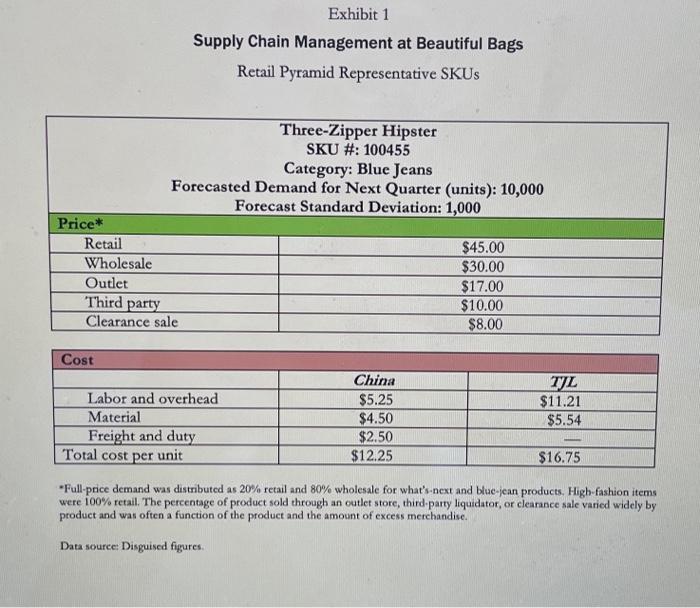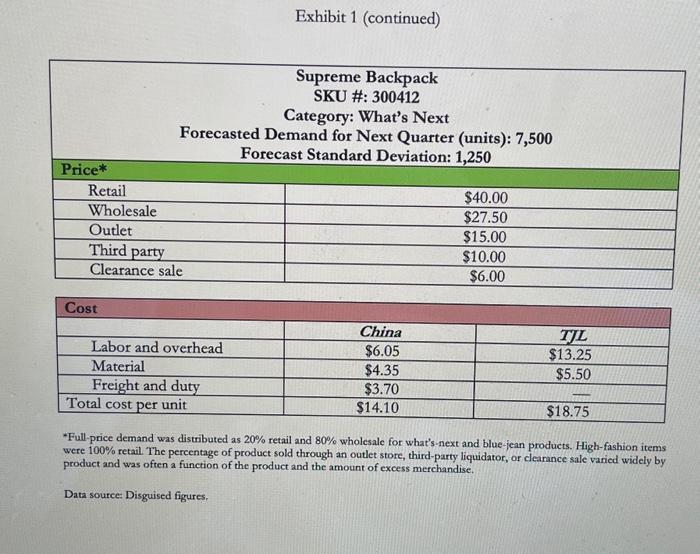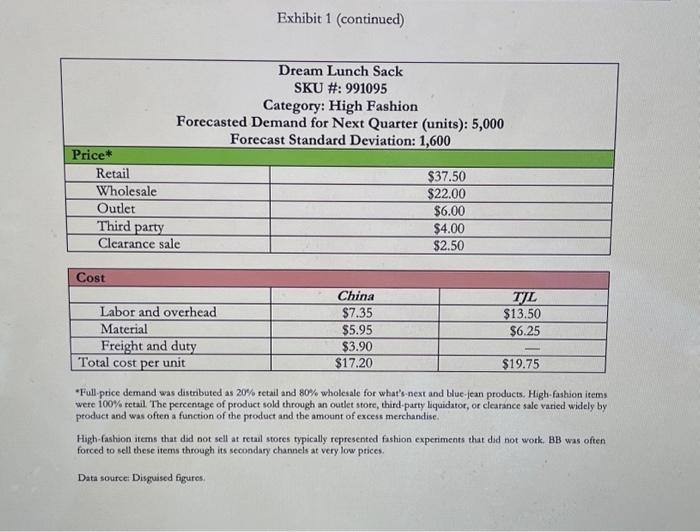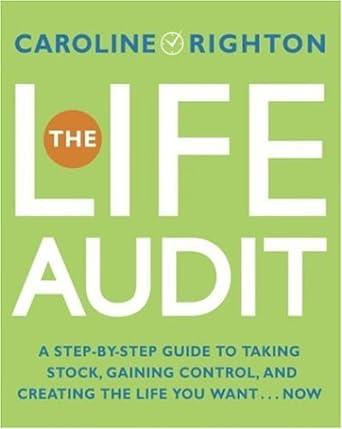Question:
Analyze all of the following inventory management approaches for each of the 3 products (Exhibit 1), and calculate quarterly expected profits and determine which approach should be used for each product. Assume that TJL facility enables a make-to-order environment, thanks to very flexible order timing and very short lead times they provide.
i. Only the Chinese supplier, for a single order.
ii. Only the TJL facility.
iii. Both suppliers.
Hint: Single order from Chinese supplier, and TJL as needed.
iv. Only the Chinese supplier, but this time to implement a Periodic Review policy.
Hint: Use T = 1 quarter, and make sure to calculate quarterly costs, including cost of the goods and holding cost of all associated inventory. Note that there are no fixed costs of ordering, and freight cost is given as a variable (unit) cost.
Note: Since all demand information is given as per quarter (1/4 of a year), use quar
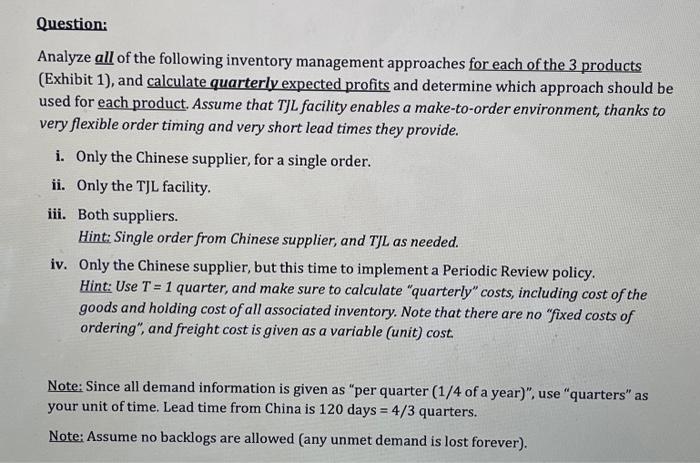
Note: Since all demand information is given as per quarter (1/4 of a year), use quarters as your unit of time. Lead time from China is 120 days = 4/3 quarters.
Note: Assume no backlogs are allowed (any unmet demand is lost forever).
Analyze all of the following inventory management approaches for each of the 3 products (Exhibit 1), and calculate quarterly expected profits and determine which approach should be used for each product. Assume that TJL facility enables a make-to-order environment, thanks to very flexible order timing and very short lead times they provide. i. Only the Chinese supplier, for a single order. ii. Only the TJL facility. iii. Both suppliers. Hint: Single order from Chinese supplier, and TJL as needed. iv. Only the Chinese supplier, but this time to implement a Periodic Review policy. Hint: Use T=1 quarter, and make sure to calculate "quarterly" costs, including cost of the goods and holding cost of all associated inventory. Note that there are no "fixed costs of ordering", and freight cost is given as a variable (unit) cost. Note: Since all demand information is given as "per quarter ( 1/4 of a year)", use "quarters" as your unit of time. Lead time from China is 120 days =4/3 quarters. Note: Assume no backlogs are allowed (any unmet demand is lost forever). Supply Chain Management at Beautiful Bags Retail Pyramid Representative SKUs -Full-price demand was distributed as 20% retail and 80% wholesale for what's-next and bluc-jean products. High-fashion items were 100% retail. The pereentage of product sold through an outlet store, third-party liquidator, or clearance sale varied widely by product and was often a function of the product and the amount of excess merchandise. Data source Disguised figures. Exhibit 1 (continued) "Full-price demand was distributed as 20% retail and 80% wholesale for what's-next and blue-jean products. High-fashion items were 100% retail. The percentage of product sold through an outlet store, third-party liquidator, or clearance sale varied widely by product and was often a function of the product and the amount of excess merchandise. Data source: Disguised figures. Exhibit 1 (continued) "Full-price demand was distributed as 20% tetail and 80% wholciale for what's-next and bluc-ecan products. High-fashion items were 100% retail The pereentage of product sold through an outlet store, third party liquidator, or clearance sale varied widely by ptoduct and was often a function of the product and the amount of excess merchandise. High-fashion items that did not sell at retail stores typically represented fashion experiments that did not wotk, BB was often forced to sell these items through its secondary channels at very low ptices. Data source: Disguised figares. Analyze all of the following inventory management approaches for each of the 3 products (Exhibit 1), and calculate quarterly expected profits and determine which approach should be used for each product. Assume that TJL facility enables a make-to-order environment, thanks to very flexible order timing and very short lead times they provide. i. Only the Chinese supplier, for a single order. ii. Only the TJL facility. iii. Both suppliers. Hint: Single order from Chinese supplier, and TJL as needed. iv. Only the Chinese supplier, but this time to implement a Periodic Review policy. Hint: Use T=1 quarter, and make sure to calculate "quarterly" costs, including cost of the goods and holding cost of all associated inventory. Note that there are no "fixed costs of ordering", and freight cost is given as a variable (unit) cost. Note: Since all demand information is given as "per quarter ( 1/4 of a year)", use "quarters" as your unit of time. Lead time from China is 120 days =4/3 quarters. Note: Assume no backlogs are allowed (any unmet demand is lost forever). Supply Chain Management at Beautiful Bags Retail Pyramid Representative SKUs -Full-price demand was distributed as 20% retail and 80% wholesale for what's-next and bluc-jean products. High-fashion items were 100% retail. The pereentage of product sold through an outlet store, third-party liquidator, or clearance sale varied widely by product and was often a function of the product and the amount of excess merchandise. Data source Disguised figures. Exhibit 1 (continued) "Full-price demand was distributed as 20% retail and 80% wholesale for what's-next and blue-jean products. High-fashion items were 100% retail. The percentage of product sold through an outlet store, third-party liquidator, or clearance sale varied widely by product and was often a function of the product and the amount of excess merchandise. Data source: Disguised figures. Exhibit 1 (continued) "Full-price demand was distributed as 20% tetail and 80% wholciale for what's-next and bluc-ecan products. High-fashion items were 100% retail The pereentage of product sold through an outlet store, third party liquidator, or clearance sale varied widely by ptoduct and was often a function of the product and the amount of excess merchandise. High-fashion items that did not sell at retail stores typically represented fashion experiments that did not wotk, BB was often forced to sell these items through its secondary channels at very low ptices. Data source: Disguised figares

